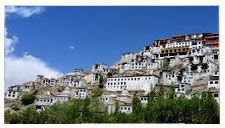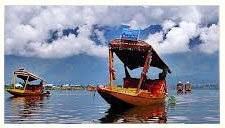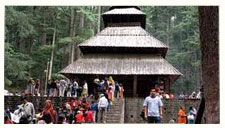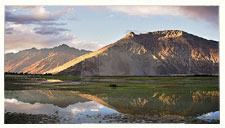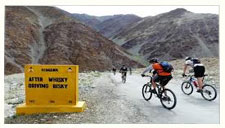Monastries in Ladakh
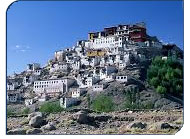 There are about 35 Buddhist Monasteries or Gompas spread across the entire region. The central area of Ladakh has the greatest concentration of major Gompas. Of the 13 major monasteries situated on or near the Indus, the oldest is that of Lamayuru, which is believed to have been a sacred site for the pre-Buddhist Bon religion. The monasteries of Phyang, Hemis and Chemrey were all founded under the direct patronage of members of the ruling Namgyal dynasty. Hemis monastery, together with that of Hanle was established at the instance of King Singge Namgyal, while his widow founded Chemrey as a posthumous act of merit for him. Stakna, dating from a slightly earlier period, was endowed by the Namgyal Kings at various times. All these belong to the Red Hat (Kargyu-pa) sect of Tibetan Monastic Order.
There are about 35 Buddhist Monasteries or Gompas spread across the entire region. The central area of Ladakh has the greatest concentration of major Gompas. Of the 13 major monasteries situated on or near the Indus, the oldest is that of Lamayuru, which is believed to have been a sacred site for the pre-Buddhist Bon religion. The monasteries of Phyang, Hemis and Chemrey were all founded under the direct patronage of members of the ruling Namgyal dynasty. Hemis monastery, together with that of Hanle was established at the instance of King Singge Namgyal, while his widow founded Chemrey as a posthumous act of merit for him. Stakna, dating from a slightly earlier period, was endowed by the Namgyal Kings at various times. All these belong to the Red Hat (Kargyu-pa) sect of Tibetan Monastic Order.
The reformist Gelugs-pa, or Yellow-Hat sect, is well represented in central Ladakh in the monsteries of Thiksey, Likir and Ri-dzong besides that of Spituk, and its branch monsteries at Stok, Sabu and Sankar. Ri-dzong, situated up a side-valley from Uley-Tokpo, was founded just about a century and half ago by a devout layman-turned-lama, with the purpose of following the strict monastic rules of the Gelugs-pa sect.
Tak-thok and Matho Gompas represent the smaller but much older Nying-ma-pa and Saskya-pa monastic sects respectively. Tak-thok, situated at the foot of the Chang-la pass, incorporates one of the many caves in the Himalayas where the Indian Buddhist apostle Padmasambhava is said to have rested and meditated on his journey to Tibet. Matho Gompa is famous for its festival of the oracles, which is held usually in March.
Among Ladakh's monastic foundations Alchi holds pride of the place as a repository of a millennium old art heritage. Known as Chos-kor, or religious enclave, it comprises five temples, the richest in paintings and images being the Du-khang (assembly hall) and the three-storey Sum-tsek. The murals dating from the 11th and 12th centuries, pre-date the Tibetan style of painting seen in all the other Gompas of the region. Some of them are presumed to be among the sole survivors of the Buddhist style prevailing in Kashmir during the first millennium AD.
The Ladakh monasteries are repositories of exquisite murals, gilded statues, religious icons, carvings, scrolls etc. built up through the ages. They remain alive with the devotions of monks, young and old. Here it is possible to receive a lama's blessing, consult an astrologer about your future, hear the wail of a horn echoing from the mountain walls, and witness a lifestyle passed down intact through the ages.
Ladakh has many historic monasteries called Gompas, where Buddhist monks and nuns live, study and practice their religion. The monasteries of Ladakh are situated in scenic locations, on hills and mountains and have rich collections of Buddhist Thangka paintings, art and artifacts. Many of the monasteries are open to tourists who can admire the architecture and art collections in these Gompas.
Some precautions to be observed while visiting a monastery:
Visitors are required to take off their shoes before entering a prayer area.
Observe local dress codes, such as wearing clothing that covers your limbs.
Do not disturb Monks at prayer, and always ask permission before taking photographs.
Do not touch religious artifacts.
Do not drink, smoke, take drugs or spit in the monastery premises Avoid talking loudly or disturbing the peaceful atmosphere Most Monasteries charge an admission fee of about Rs. 25 to 50. If a fee is not charged, it is considered appropriate to leave a donation for the maintenance of the monastery. In many Monasteries, you are expected to walk around the premises only in a clockwise direction. Women may not be allowed to enter the inner prayer rooms of some monasteries.
Monasteries of Ladakh
Lamayuru Gompa
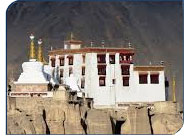 Location 125 Km from Leh
Location 125 Km from Leh
Founded in 11th century by Mahasiddhacharya Naropa
Lamayuru Monastery is situated in Ladakh, in between Bodhkharbu and Kha-la-che, on a steep rock mountain. It lies at a distance of approximately 127 km to the west of Leh town. Lamayuru Monastery belongs to the Red-Hat sect of Buddhism and houses approximately 150 Buddhist monks. The monastery is made up of a number of shrines and also has a very rich collection of thankas and magnificent wall paintings. At the outset, the Lamayuru Monastery consisted of five buildings, out of which only the central one exists today. Every year the Lamayuru Gompa plays host a masked dance, which takes place on the 17th and 18th day of the 5th month of Tibetan lunar calendar. Today, the Lamayuru Monastery is served by the successive reincarnations of Skyabsje Toldan Rinpoche.
Alchi Gompa
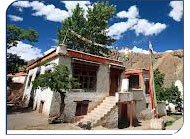 Location 67 Km from Leh
Location 67 Km from Leh
Founded in 1000 AD by Rinchen Zangpo1000 AD
Alchi Gompa dates back to the year 1000 AD and was built by the Translator, Rinchen Zangpo. He even made a reference about the monastery in his biographies. It is written that he brought thirty-two sculptors and wood carvers from Kashmir, for the construction of the Alchi Monastery of Leh Ladakh. The monastery is sited at a distance of approximately 67 km to the west of Leh. One can easily see an Indian touch in this monastery, especially in the way its paintings have been made. Three sacred temples, with the main one being that of Rinchen Lhakhang at Lotsa Lhakhang, make up a major part of the Alchi Gompa of Ladakh.
Likir Gompa
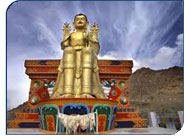 Location 60 Km from Leh
Location 60 Km from Leh
Founded in 9th century by Lama Duwang Chusje
The monastery is situated at a distance of approximately 62 km to the west of Leh town. Lhachen
The Likkir Monastery of Leh Ladakh was founded in the later half of the 11th century, around the year 1605. It belongs to the Yellow Hat Sect, founded by Tsongkhapa. It consists of a number of shrines inside its complex. Presently, it serves as the residence of approximately 120 Buddhist monks. The monastery also has a school, in which almost thirty students study. In the 15th century, Likir Gompa came under the influence of Lodos Sangphu. A disciple of Khasdubje, he made efforts to see that the monastery flourished and prospered..
Rhizong
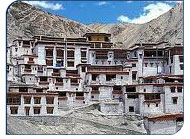 Location 70 Km from Leh
Location 70 Km from Leh
Founded in 1831 AD by Lama Tsultim Nima
The Rizong Gompa of Ladakh was founded by the great Lama Tsultim Nima in the year 1831. It belongs to the Gelukpa Order, and is situated at a distance of approximately 73 km from the Leh town. The monastery serves as the residence of approximately 40 monks. Rizdong Monastery of Leh Ladakh consists of a number of shrines inside its complex. The gompa also has quite a rich collection of the painting blocks of Lama Tsultim Nima's biography as well as a number of objects made and books composed by the first Sras Rinpoche. A nunnery, known as Chulichan (Chomoling) is located near the monastery, at a distance of approximately 2 km. Comprising of about 20 nuns, the nunnery is under the control of the governing body of Rizong Monastery only.
Phyang Monastery
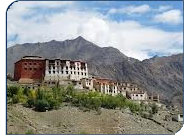 Location 26 Km from Leh
Location 26 Km from Leh
Founded in1515 by Chosje Damma Kunga
Phyang Monastery of Ladakh is situated at a distance of approximately 26 km to the west of the Leh town. It belongs to the Red Hat Sect of Buddhism. The hill of Phyang served as the venue of a monastery, known as Tashi Chozong, established in the year 1515. It also has its 900 years old museum. Its rich collection boasts of numerous idols, thankas, Chinese, Tibetan and Mongolian firearms and weapons, etc. The festival of Gang-Sngon Tsedup is held every year from 17th day to 19th day of the first month of the Tibetan calendar. The monastery also serves as the venue of the sacred dances, held every year on the 2nd and 3rd of the 6th month of the Tibetan calendar.
Spituk Monastery
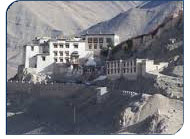 Location 7 Km from Leh
Location 7 Km from Leh
Founded by Od-de, the elder brother of Lha Lama Changchub Od in 11th century
Spituk Gompa of Ladakh dates back to the 11th century. It owes its inception to Od-de, the elder brother of Lha Lama Changchub Od. Od-de led to the establishment of a monastic community at this place. A three-chapel monastery, Spituk is located at a distance of approximately 8 km from the town of Leh. The name "Spituk", meaning exemplary, has been derived from a statement of a translator, Rinchen Zangpo, about the monastery. He said that an exemplary religious community would develop there, providing the name Spituk for the monastery.
The festival takes place from the 27th to 29th day in the eleventh month of the Tibetan calendar. A sacred dance also forms a part of the celebrations.
Namgyal Tsemo
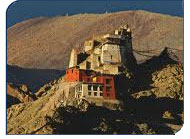 Location in Leh town Just above the leh Palace on a Hill
Location in Leh town Just above the leh Palace on a Hill
Founded by King Tashi Namgyal in 1430 AD
Namgyal Tsemo Gompa was founded in the early 15th century, around the year 1430. It stands atop the crag behind Leh palace, having a full view of the town of Leh. And because of this position, it offers some of the most splendid visuals of the town. The Namgyal Tsemo Gompa of Ladakh was founded by King Tashi Namgyal and has been named after him only. It boasts of a rich collection of some ancient manuscripts and wall paintings. One of the most treasured possessions of the monastery is a three-story high solid gold idol of Maitrieya Buddha (future Buddha, also known as the laughing Buddha). Namgyal Tsemo Monastery of Leh Ladakh also houses a statue of Avaloketesvara and Manjushri, approximately one story high.
Sankar Gompa
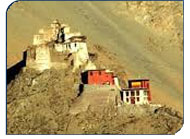 Location 1 Km north of Leh
Location 1 Km north of Leh
Sankar Gompa of Ladakh is located at a distance of approximately 3 km from the town of Leh. A subsidiary of the Spituk Gompa, it belongs to the Gelukpa or the Yellow Hat Sect. The monastery also serves as the official residence of the Ladakh's head of Gelukpa Sect, known as The Kushok Bakul. There are time restrictions for visiting the Sankar Monastery of Leh Ladakh. You can also go either between 7:00 am and 10:00 am, or between 5:00 pm and 7:00 pm. These restrictions have been placed because a few of the monks, of the yellow-hat sect, attached to the monastery reside here permanently. Sankar Gompa also has the possession of Kandshur, the 108 volumes of Buddha's teachings.
Shanti Stupa
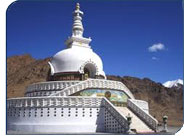 Situated in Leh Town near Changspa
Situated in Leh Town near Changspa
Founded by a Japaneese Monk in 1984
Shanti Stupa of Ladakh is located on the hilltop at Changspa. It can be reached quite easily from the Fort Road. The Stupa was constructed by a Japanese Buddhist organization, known as 'The Japanese for World Peace'. The aim behind the construction of the stupa was to commemorate 2500 years of Buddhism and to promote World Peace. His Holiness, the Dalai Lama inaugurated the Shanti Stupa in the year 1985. A magnificent white-domed structure, the Shanti Stupa of Leh Ladakh offers spectacular views of the sunrise and sunset. The stupa looks best at night, when it is beautifully illuminated with glittering lights. A large number of tourists come to Ladakh every year to visit this amazing stupa.
Chemrey Gompa
 Location: 45 Km
Location: 45 Km
Founded in 17th century by Lama Tagsang Raschen
Chemrey Gompa of Ladakh was founded by Lama Tagsang Raschen and dates back to the 17th century. Situated at a distance of approximately 40 km to the east of the town of Leh, this monastery belongs to the Drugpa Order. Infact, it serves as the residence of approximately 20 monks of the diminishing Drugpa community, and also their young apprentices. Chemrey Monastery of Leh Ladakh was initially built to serve as a memorial to King Sengge Namgyal. There are a number of shrines situated inside the monastery. However, one of the major attractions of the Chemrey Gompa is the one-story high image of Padmasambhava it houses. The monastery also serves as the venue for the festival of sacred dances. The festival takes place, on an annual basis, on the 28th and 29th day of the 9th month of the Tibetan calendar
Takthok Monastery
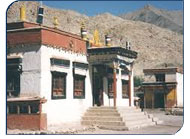 Takthok Monastery of Ladakh is situated in Sakti Village, at a distance of approximately 51 km from the town of Leh . The site where the monastery is now situated, once served as the meditation cave of Mahasidhas "Kunga Phuntsog". The name Takthok literally means 'rock-roof'. The monastery was so named, as both its roof as well as walls are made up of rock. Tak Thok belongs to the Nying-ma-pa sect of Buddhism, also known as the Old Order, and serves as the residence of approximately 55 lamas.
Takthok Monastery of Ladakh is situated in Sakti Village, at a distance of approximately 51 km from the town of Leh . The site where the monastery is now situated, once served as the meditation cave of Mahasidhas "Kunga Phuntsog". The name Takthok literally means 'rock-roof'. The monastery was so named, as both its roof as well as walls are made up of rock. Tak Thok belongs to the Nying-ma-pa sect of Buddhism, also known as the Old Order, and serves as the residence of approximately 55 lamas.
It is the probably the only Gompa in Ladakh that follows this order. Every year a festival is held at the Tak Thok Gompa of Leh Ladakh, on the 9th and 10th day of the sixth month of the Tibetan calendar. Celebrations of the festival include sacred dances and the ceremony of hurling a votive offering.
Hemis Monastery
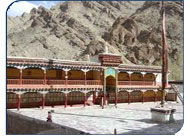 Location: 46 Km
Location: 46 Km
Founded in 1630 by First incarnation of Stagsang Raspa Nawang Gyatso
Hemis Monastery holds the distinction of being the biggest as well as the wealthiest monastery of Ladakh. It dates back to the year 1630 and was founded by the first incarnation of Stagsang Raspa Nawang Gyatso. Hemis Monastery is positioned inside a gorge, at a distance of approximately 47 km from Leh. Belonging to the Dugpa Order, it stands on the western bank of the Indus River. The monastery also boasts of a very rich collection of ancient relics. The Hemis Monastery also serves as the venue of an annual festival, known as the Hemis Festival. This festival is celebrated as a commemoration of the birth anniversary of Guru Padmasambhav. On the day of the Hemis Festival, the thangka of the monastery is displayed, with a gap of twelve years between successive displays. The Thanka is the sacred appliqué-work tapestry wrought with pearls, which depicts Guru Padmasambhava. And not to be forgotten is a sacred mask dance that is performed at the monastery every year. The dance takes place on 9th and 10th day of the fifth month of the Tibetan calendar.
Stakna Monastery
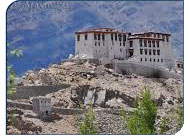 Location 25 Kms from Leh
Location 25 Kms from Leh
Founded by Chosje Jamyang Palkar in 16th century.
Stakna Gompa of Ladakh is situated on the right bank of the Indus River, at a distance of approximately 25 km from the town of Leh. The name, 'Stakna' literally means 'tiger's nose'. The monastery was so named because it was built on a hill, which is shaped just like a tiger's nose. Stakna Monastery of Leh Ladakh owes its inception to Chosje Jamyang Palkar, the great scholar saint of Bhutan. It formed a part of the many religious estates offered by the Dharmaraja Jamyang Namgial to the saint, around 1580 AD.
Thiksey Gompa
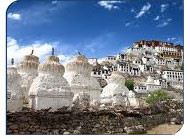 Location Thicksey Village 20 Kms from Leh
Location Thicksey Village 20 Kms from Leh
Founnded in 1430 AD. By Spon Paldan Sherab, nephew of Sherab Zangpo
Thiksey Gompa of Ladakh is situated at a distance of approximately 18 km from the town of Leh. One of the most beautiful monasteries of Ladakh, it belongs to the Gelukpa Order of Buddhism. Sherab Zangpo of Stod got the Thikse Monastery built for the first time, at Stakmo. However, later Spon Paldan Sherab, the nephew of Sherab Zangpo, reconstructed the monastery in the year 1430 AD. The new monastery was sited on a hilltop, to the north of Indus River. Thikse Monastery of Leh Ladakh houses a temple, known as Lakhang Nyerma. This temple, built by Rinchen Zangpo, the Translator, is dedicated to Goddess Dorje Chenmo. A huge temple in its time, today it stands mostly in ruins. Apart from this temple, there are a number of other sacred shrines inside the monastery complex. The monastery also has a rich collection of numerous valuable artifacts and ancient relics.
Thiksey Gompa serves as the residence of approximately eighty monks. It has been served, for quite a long time, by the successive reincarnations of the Skyabsje Khanpo Rinpoche. The monastery also plays the host to Gustor ritual, organized from the 17th to 19th day of the ninth month of the Tibetan calendar. Sacred dances also form a part of this ritual, which takes place on an annual basis.
Shey Palace & Gompa
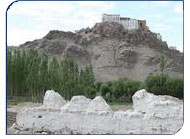
Location : 14 Kms from Leh
Founded by King Deldan Namgyal in 17th century
Shey Gompa of Ladakh is situated on a hillock, at a distance of approximately 15 km to the south of Leh town. The monastery was erected on the instructions of King Deldon Namgyal, in the memory of his late father, Singay Namgyal. The main image inside the Shey Monastery is that of Buddha Shalyamuni. It is a huge image of the seated Buddha and is considered to be the biggest metal statue and the second largest Buddha statue in the Ladakh region. Copper sheets, gilded with gold, make up this amazing Buddha statue. An annual festival is also held at Shey Gompa, on the 30th day of the first month of the Tibetan calendar.
Stok Gompa
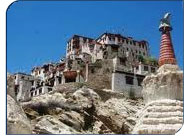 Location 14 kms from Leh
Location 14 kms from Leh
Lama Lhawang Lotus in 14th Century
Stok Gompa of Ladakh is situated at a distance of approximately 15 km to the south of the Leh town. It dates back to the 14th century and was founded by Lama Lhawang Lotus. Stok is a subsidiary of the Spituk Gompa and belongs to the yellow-hat sect of Buddhism. As you enter the verandah of the monastery, you will come across bright friezes, depicting the Guardians of the Four Directions. The Dukhang of the monastery was repainted, not a long time back, and displays a rich collection of banners and thankas. A new temple, dedicated to Avalokitesvara, was added to the monastery some time back. The central image inside the temple is that of Avalokitesvara, with his 1,000 arms and 11 heads. A ritual dance-mask takes place near the gompa, on the 9th and 10th day of the first month of the Tibetan calendar.
Diskit Gompa
 Location: Nubra valley 130 Kms from Leh
Location: Nubra valley 130 Kms from Leh
Founded by Changzem Tserab Zangpo in 14th century.
Both the Diskit Gompa as well as the Hundur Gompa are situated in the Nubra Valley of the Ladakh region. Situated quite near the monasteries, at a slightly higher altitude, is Lachung Temple. One of the oldest temples of this area, the temple has a huge idol of Tsong-kha-pa, crowned with a Gelugpa yellow hat. Hundur Monastery of Leh Ladakh is situated just below the main road, near the bridge and Diskit Monastery is situated nearby. The Diskit Gompa dates back to the 14th century and owes its inception to Changzem Tserab Zangpo, a disciple of Tsong-kha-pa. At the heart of Diskit Monastery is an elevated cupola, which stands adorned with a beautiful fresco that illustrates the Tashilhunpo Gompa of Tibet. There are a number of shrines inside the monastery's complex, like Kangyu-lang, Tsangyu-lang, etc. Also, hundreds of Mongolian and Tibetan texts have found their storehouse inside these temples. Diskit Gompa has quite an interesting legend attached to it. It is believed that a Mongol demon once lived here and was considered to be a sworn enemy of Buddhism. He was annihilated near the monastery. However, even after his death, his body kept coming back to the monastery again and again. It is said that even today the wrinkled head and hand of the demon lie inside a temple of the monastery, which is filled with fierce Gods and Goddesses.
Monasteries of Ladakh
A. Monasteries between Leh-Kargil Road
Spituk Monastery
Phyang Monastery (West)
Basgo Palace (West)
Liker Gompa (West)
Rezong Monastery
Alchi Choskor (West)
Sumda Chun Monastery South-East
Temisgam Palace (North)
Lamayuru Monastery (West)
B. Monasteries between Leh-Manali Road
Shey Monastery and Palace
Thiksey Monastery south
Stakna Monastery East
Hemis Monastery South
Chemde Gompa
Takthok Monastery
Mangyu Monastery South
Korzok Gompa
C. Monasteries around Leh Town
Tsemo in Leh
Shanti Stupa
Sankar Gompa
Gompa Soma (Jokhang), Leh
Stok Monastery and Palace South-East
Matho Gompa South-East
D. Monastery’s in Nurba Valley
Deskit Monastery Nurba Valley
Hundar
Samstanling in Sumur
E. Monastery’s in Zanskar Valley
Karsha village of the Zanskar region.
Zongkhul
Stongdey
Gelugpa monastery at Karsha
Stakrimo monastery at Padum
Phuktal
Barban







 Thanks a lot for special and memorable holidays in leh Ladakh thank you so so much-really appreciate your fantastic service which you did for us!
Thanks a lot for special and memorable holidays in leh Ladakh thank you so so much-really appreciate your fantastic service which you did for us!


